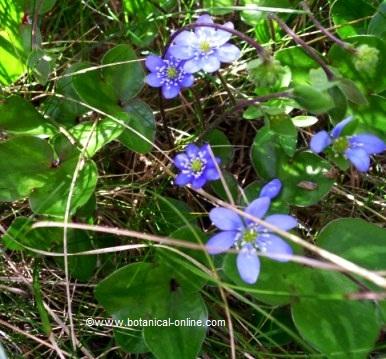Contents
What is liverleaf?
Characteristics of liverleaf (Hepatica nobilis)
Common name: liverleaf, liverwort, hepatica, round-lobed hepatica, liverweed, trefoil, trinity herb, kidneywort, pennywort, American liverleaf
– Spanish / Español: hierba hepática, hepática de los jardines, trinitaria, hierba de la Trinidad, trébol dorado, hepática noble

Scientific name: Anemone hepatica L. = Hepatica nobilis Schreb.
Other taxonomic names (not accepted):
– Hepatica nobilis Molino.
– Hepatica triloba Chaix.
– Anemone acutiloba (DC.) G. Lawson
Family: Ranunculaceae or buttercup family
Ranunculus is derived from Latin and means “small frog”. The name probably refers to the fact that many of the species in this family are found in humid environments, like frogs, and that most of the plants are small in size.
Origin: plant of Eurosiberian origin. Naturalized in North America, from Minnesota to Missouri.
Habitat: Liverleaf can be found in cool places, deep forests and undergrowth, very humid and shady places. Bushes, grasslands, grassy or leafy slopes, deciduous woods, pine forests, beech forests, oak forests, etc. Cultivated in gardens. This herb is indicative of calcareous soils, as it can grow in very alkaline soils. Liverleaf grows in the same places as violets, being two plants that often, in the wild, grow side by side.
Distribution of liverleaf
Northern Hemisphere of Europe, Asia and North America. It is found in Russia, China (Anhui, Henan, Liaoning, Zhejiang); Japan (Honshu, Kyushu, Shikoku); North Korea, South Korea, Europe (Denmark, Finland, Norway, Sweden, Austria, Czechoslovakia, Germany, Poland, Switzerland, Belarus, Ukraine, Albania, Bulgaria, Italy, Romania, France, Spain).
Botanical Classification of liverleaf
| Botanical classification | |
| Kingdom | Plantae – Plants |
| Subkingdom | Tracheobionta Vascular plants |
| Superdivision | Spermatophyta Seed plants |
| Division | Magnoliophyta or Angiosperms Flowering plants |
| Class | Magnoliopsida or Dicotyledoneae |
| Order | Ranunculales |
| Family | Ranunculaceae or buttercup family |
| Subfamily | Ranunculoideae |
| Tribe | Anemoneae |
| Genus | Anemone |
| Species | A. hepatica |
Description of liverleaf

Liverleaf or liverwort (Anemone hepatica) is a low-growing perennial plant, up to 5 – 20 cm high. This plant owes its name to the fact that, like the human liver, its leaves have three entire lobes (in the liver: left lobe, right lobe and gallbladder).
The leaves are acaulescent, arising directly from the rhizome or underground stem of the plant. They are petiolate, entire, glabrous, with an obtuse apex and a characteristically trilobed limb.
The underside of the leaves is reddish and has fine white hairiness, while the upper side is lustrous and has pale mottling.
The liverleaf is one of the first spring flowers, blooming from February to March. The flowers are solitary and are arranged at the end of long peduncles of 5-15 cm.. They are made up of 6-9 petals, violet, white or purple in colour, which are arranged in sets of two. Flower parts: 5 sepals, stamens 2-6 mm., anthers 0.7 mm. and ovary densely hairy.
The flowers are hermaphrodite and are pollinated by bees, beetles and lepidopterans.
The fruit is an indehiscent achene 4 mm long, ovate, hairy and pointed.
Used parts
- The leaves. These are collected during the flowering season and carefully dried.
- The rhizome contains medicinal components, and some authors give it medicinal properties. They are harvested in spring, before flowering.

Photograph of liverleaf population in the wild
Uses of liverleaf
- Medicinal plant: Liverwort is a poisonous plant with medicinal uses, although due to its toxicity, it is not currently used internally. It has diuretic, astringent and vulnerary properties. Liverwort has rubefacient or irritant properties, which produce reddening in the area where it is applied as a poultice, with the consequent increase in heat and blood flow. It is used to treat rheumatism, neuralgic pain, sciatica and arthritis.
- The dried plant does not contain any toxic ingredients, as they are broken down into harmless substances. Liverleaf is only used dried and externally.
- Liverleaf is NOT an edible plant.
Composition of liverleaf
Like all plants belonging to its family, liverleaf contains ranunculin, a glycoside that breaks down into the toxin protoanemonin. This is a toxic substance, which disappears when the plant is dried.
Numerous intoxications have been described in animals, as it is toxic to cows, horses and pigs. Just as in animals, hepatica has toxic effects in humans, so it is not recommended to use the fresh plant internally. High doses of this plant are toxic.
- Flavonoid glycosides: heteroside components of quercetol and kaempferol. They give liverleaf vulnerary properties, and are present in other plants with the same applications, such as arnica. The hepatilobin glycoside stands out.
- Mucilage: mucilage is a type of fiber of viscous nature. It is applied in poultice or poultice for the protection of wounds, and in the liverleaf, it helps to alleviate its rubefacient or irritating effects, produced by ranunculin.
- Condensed tannins: tannins are polyphenolic compounds that are very astringent and have a bitter taste.
- Saponins
![]() More information on liverleaf
More information on liverleaf









